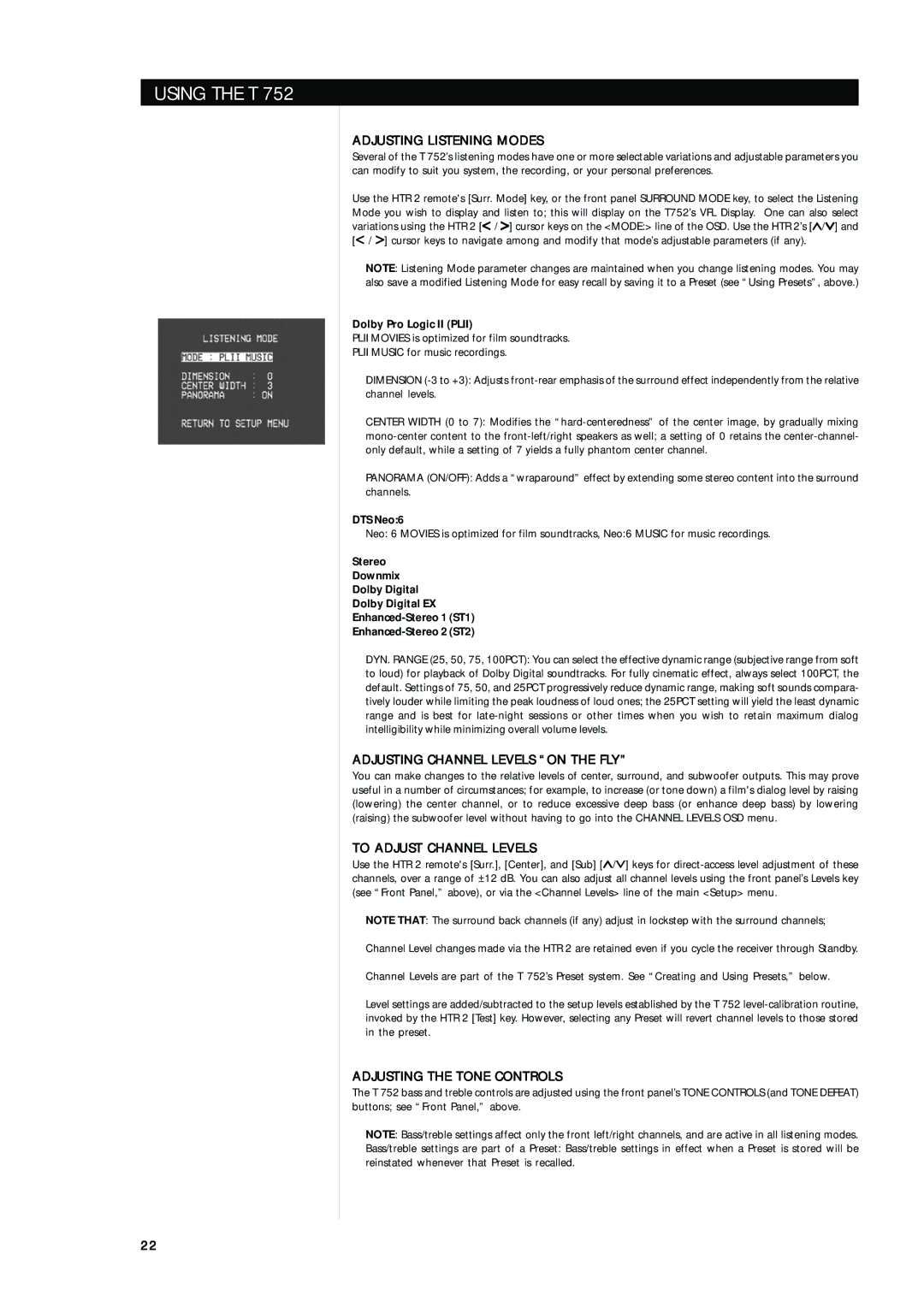
USING THE T 752
ADJUSTING LISTENING MODES
Several of the T 752’s listening modes have one or more selectable variations and adjustable parameters you can modify to suit you system, the recording, or your personal preferences.
Use the HTR 2 remote's [Surr. Mode] key, or the front panel SURROUND MODE key, to select the Listening Mode you wish to display and listen to; this will display on the T752’s VFL Display. One can also select variations using the HTR 2 [< / > ] cursor keys on the <MODE:> line of the OSD. Use the HTR 2’s [∧ /∨ ] and [< / > ] cursor keys to navigate among and modify that mode’s adjustable parameters (if any).
NOTE: Listening Mode parameter changes are maintained when you change listening modes. You may also save a modified Listening Mode for easy recall by saving it to a Preset (see “Using Presets”, above.)
Dolby Pro Logic II (PLII)
PLII MOVIES is optimized for film soundtracks.
PLII MUSIC for music recordings.
DIMENSION
CENTER WIDTH (0 to 7): Modifies the
PANORAMA (ON/OFF): Adds a “wraparound” effect by extending some stereo content into the surround channels.
DTS Neo:6
Neo: 6 MOVIES is optimized for film soundtracks, Neo:6 MUSIC for music recordings.
Stereo
Downmix
Dolby Digital
Dolby Digital EX
Enhanced-Stereo 1 (ST1)
Enhanced-Stereo 2 (ST2)
DYN. RANGE (25, 50, 75, 100PCT): You can select the effective dynamic range (subjective range from soft to loud) for playback of Dolby Digital soundtracks. For fully cinematic effect, always select 100PCT, the default. Settings of 75, 50, and 25PCT progressively reduce dynamic range, making soft sounds compara- tively louder while limiting the peak loudness of loud ones; the 25PCT setting will yield the least dynamic range and is best for
ADJUSTING CHANNEL LEVELS “ON THE FLY”
You can make changes to the relative levels of center, surround, and subwoofer outputs. This may prove useful in a number of circumstances; for example, to increase (or tone down) a film's dialog level by raising (lowering) the center channel, or to reduce excessive deep bass (or enhance deep bass) by lowering (raising) the subwoofer level without having to go into the CHANNEL LEVELS OSD menu.
Use the HTR 2 remote's [Surr.], [Center], and [Sub] [∧ /∨ ] keys for
NOTE THAT: The surround back channels (if any) adjust in lockstep with the surround channels;
Channel Level changes made via the HTR 2 are retained even if you cycle the receiver through Standby.
Channel Levels are part of the T 752’s Preset system. See “Creating and Using Presets,” below.
Level settings are added/subtracted to the setup levels established by the T 752
ADJUSTING THE TONE CONTROLS
The T 752 bass and treble controls are adjusted using the front panel’s TONE CONTROLS (and TONE DEFEAT) buttons; see “Front Panel,” above.
NOTE: Bass/treble settings affect only the front left/right channels, and are active in all listening modes.
Bass/treble settings are part of a Preset: Bass/treble settings in effect when a Preset is stored will be reinstated whenever that Preset is recalled.
2 2
